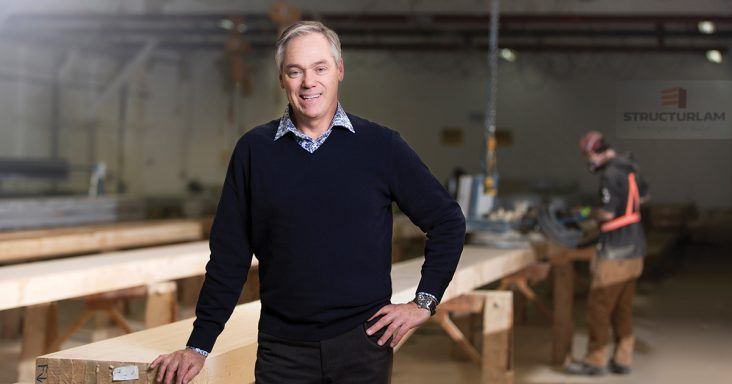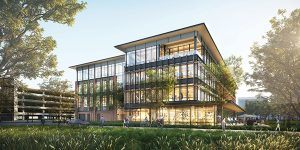Canadian firm Structurlam hoping Walmart campus, Conway plant will spur mass timber popularity in U.S.
by February 11, 2020 11:25 am 6,712 views

Hardy Wentzel, CEO of Canadian-based manufacturing company Structurlam Mass Timber Corp. The company will be the exclusive supplier of engineered wood products for the office buildings in the construction of Walmart's new corporate campus in Bentonville.
In early 2018, Structurlam Mass Timber Corp. hired Hardy Wentzel as its new CEO. He had a prioritized strategic plan: Expand the Canadian-based manufacturing company with a southern U.S. facility.
In Bentonville, Walmart had decided its new corporate campus — first announced in August 2017 — would be built using structural timber or, as it’s more popularly known, “mass timber” (short for “massive timber”). The retailer was scanning the industry for a potential supplier.
And in central Arkansas, a 288,000-square-foot facility that Nucor Steel initially built to make steel fasteners sat empty in Conway.
With those puzzle pieces on the table, Wentzel jokingly said he had one job.
“The stars seemed to align very quickly,” Wentzel recalled. “My job as the CEO of Structurlam was, ‘Don’t mess this up, Hardy.’”
The opportunity did not slip away from Wentzel. In December, 19 months after Wentzel’s first discussion with Walmart real estate executives, Structurlam announced it would invest $90 million to buy, retrofit and equip the former Nucor plant in Conway. When it comes online in mid-2021, the facility will support Walmart as the exclusive supplier of engineered wood products for the office buildings in its new corporate campus.
Structurlam is considered a pioneer in transforming lumber into processed timber strong enough to use as building materials. The company will use approximately 1.1 million cubic feet of its mass timber products in the Walmart corporate campus, situated on roughly 350 acres between Arkansas Highways 72 and 102. The anticipated floor area will be over 2 million square feet of office space used in 10 mid-rise office buildings.
Walmart will not use mass timber for structures that are not office buildings, according to spokeswoman Anne Hatfield. That includes, for example, a 400,000-square-foot layout center at 2101 S.E. Eighth St. Crossland Construction recently pulled a $73.05 million building permit to begin that project.
Speaking with the Northwest Arkansas Business Journal, Wentzel said the new Walmart corporate campus is far and away the largest project Structurlam has supplied.
“We’ve done a lot of large projects with some other iconic [companies],” he said. “In Silicon Valley, we are very active with some tech sector companies [that] have similar desires about sustainability and desires to build faster and build a great place for people to come work. But this [Walmart] project, by many factors, will be the largest mass timber project for a while. Probably globally.”
MASS TIMBER 101
The concept of mass timber construction hasn’t taken off in the U.S. as it has in other parts of the world. Wentzel, who served in key positions in some of the industry’s largest companies before joining Structurlam in January 2018, said that trend is slowly starting to change. There’s evidence of that in Northwest Arkansas. America’s largest mass timber building opened last year at the University of Arkansas in Fayetteville. Spread across a series of interconnected structures, Adohi Hall is a 202,027-square-foot residential project constructed from cross-laminated timber (CLT).
Founded in 1962, Structurlam was the first manufacturer to bring mass timber to market in North America, and the company has completed 250 mass timber construction projects in Canada and the U.S. since 2015.
“[Mass timber] has been an active building system in Europe for almost 30 years now,” Wentzel said. “We were watching Europeans do this for a long time. We converted it to our standards, and now we have a product.
“Wood is good again, and that’s great.”
According to Virginia-based trade association American Wood Council, mass timber is a term used to describe several large engineered wood products that typically involve the lamination and compression of multiple layers to create solid panels of wood. Mass timber construction uses solid wood panels to frame a building’s walls, floors and roofs.
Two popular types of mass timber products include CLT and glue-laminated timber, or glulam.
“Glulam creates the framework of the structure; the backbone,” Wentzel explained. “And the CLT is the panel product. In the case of the Walmart project, they will be 12-foot wide by 60-foot long panels. They become the skin. They wrap the building. Floors, roofs and walls.”
There are other benefits to mass timber construction, Wentzel said. Mass timber buildings require 90% less construction material delivery traffic and 75% fewer workers on site.

They are also roughly 25% faster to construct than concrete buildings. Brock Commons Tallwood House, a student residence building at the University of British Columbia in Vancouver, is the world’s tallest mass timber building. At 18 stories, it was constructed in nine weeks, at an average rate of two floors per week. Structurlam provided the products.
Surprisingly, mass timber is also resistant to fire. Wentzel explained that it slowly chars rather than bursts into flames like smaller lumber.
But the most significant thing capturing the imagination of builders and architects, Wentzel said, is mass timber is seen as a sustainable and more carbon-friendly alternative to steel and concrete.
“There is no other building material that is more sustainable than mass timber,” he said. “That’s a full-stop period. What we use to make a building and what we have to do to keep that building warm or cool is the largest contributor to greenhouse gas. So by using a carbon-sequestering product like mass timber, you alleviate a lot of that problem.”
Wentzel said the mass timber produced in Conway for Walmart’s corporate campus will be 100% sourced from Arkansas timber.
‘PLATFORM OF CHOICE’
Looking ahead, Wentzel said building renovation and construction at the Conway facility have started, and specialized wood processing equipment will arrive on-site during the second half of the year. At full strength, the plant will create 130 new jobs and a combined capacity sufficient to construct three 200,000-square-foot office buildings every month.
That kind of capability means Structurlam can sell CLT, glulam and other products to several different customers besides Walmart. Once the Conway plant is running, Structurlam will be operating two mass timber plant operations in North America — its original plant in British Columbia and the new plant in Arkansas. The two plants will allow Structurlam to efficiently flex production between the locations to serve customers across North America.
“Our forecasts indicate that although substantial, the Walmart project order flow will represent less than 50% of our plant’s annual capacity over the four-year delivery period, allowing Structurlam to develop relationships with many new customers,” Wentzel said. “The plant in Conway, as is our other plant in British Columbia, are custom product manufacturing plants. Everything is a new order. So we need to have other third-party customers and businesses to slot into our production line to keep the plant going and the employees active.”
Structurlam is working carefully with global design firm Gensler to oversee the massive Walmart project in Bentonville. Attempts by the Northwest Arkansas Business Journal to schedule an interview with Gensler were not successful.
Wentzel said the two companies had worked together in the past, and mass timber is quickly becoming a platform of choice for architects and builders, especially as governments make it easier to allow for taller buildings by updating building codes.
For example, the International Building Code (IBC), adopted for use as a base code standard by most jurisdictions in the United States, incorporated CLT in 2015.
The IBC is updated every three years and starting with the 2021 version, mass timber buildings in the U.S. will be allowed up to 18 stories.
“When you see these mass timber projects completed, they’re beautiful, absolutely beautiful and stunning,” Wentzel said. “What Walmart is designing is going to be beautiful and natural architecture that captures the essence of Arkansas in terms of trees and outdoors and green space.”
